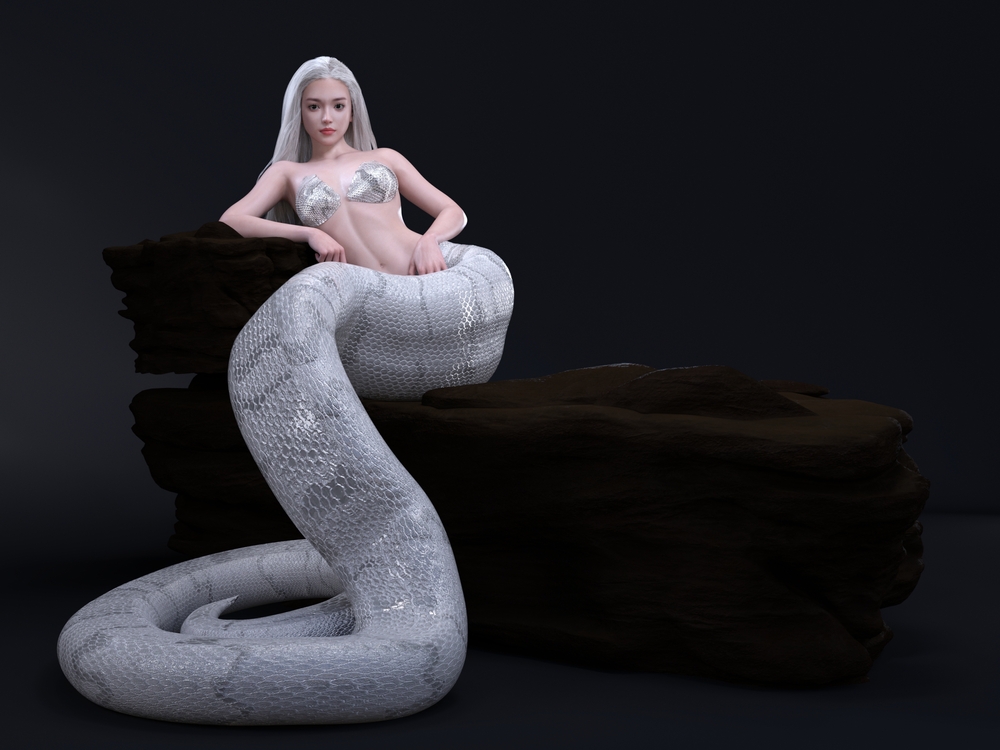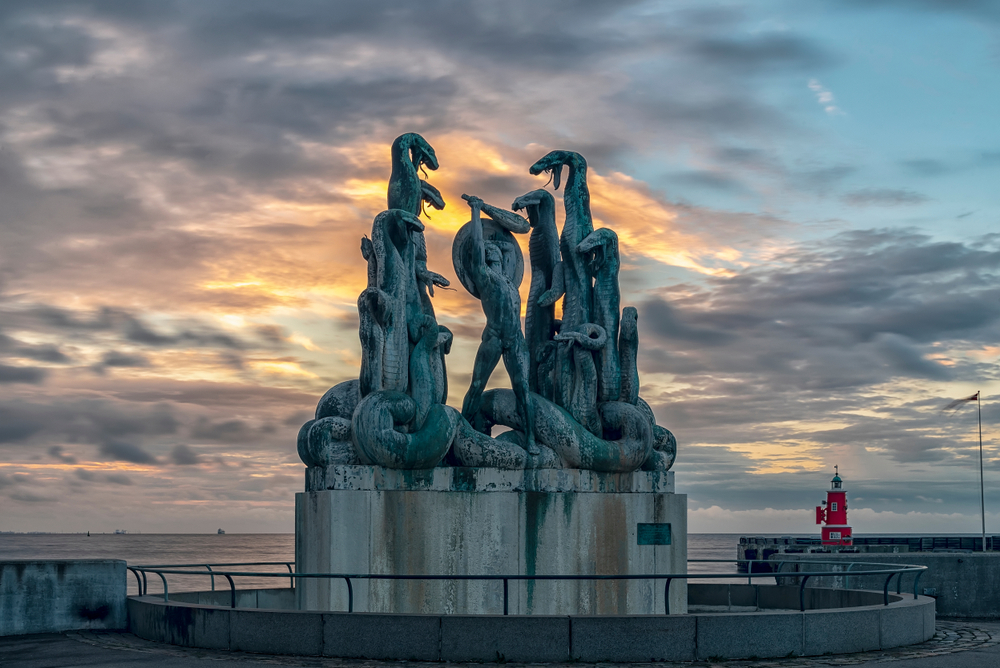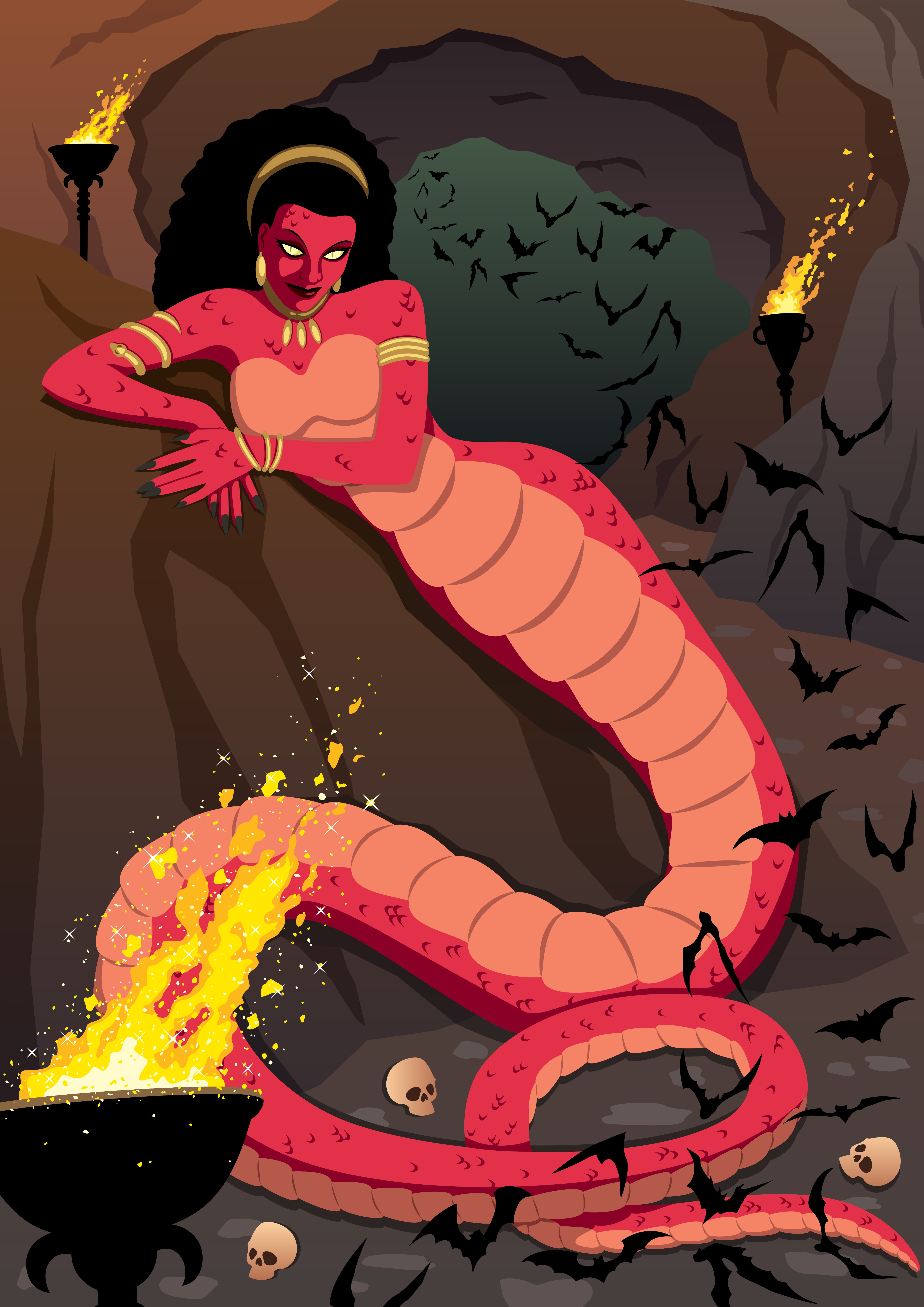Echidna is a powerful figure in Greek mythology, often referred to as the "Mother of Monsters.” Her story intertwines with many of the famous myths and legends that have influenced art, literature, and culture throughout the centuries. This blog post explores Echidna's identity, powers, symbols, and role in ancient Greek myths.
Jump to:
Who Was Echidna?

Echidna is a fearsome and fascinating creature in Greek mythology. She is often depicted as a beautiful woman from the waist up and a fearsome snake from the waist down. This hybrid form makes her one of the most distinctive and memorable figures in mythology.
The Powers and Symbols of Echidna
What Powers Did Echidna Have?
As a seminal figure in Greek mythology, Echidna possessed significant powers. Her hybrid form allowed her to move between the worlds of humans and gods, influencing both realms. Her children, each possessing their own terrifying attributes, reflect her formidable nature.
Symbols Associated with Echidna
Echidna's symbolism is deeply tied to her form and powers. She represents the ultimate chaos and destruction that mythical monsters can bring to the world. However, her human-like upper half suggests a connection to humanity, blurring the lines between the monstrous and the known.
Recommended for you!
Best SellersEchidna's Family Tree and Relationships

Echidna's family tree and relationships significantly shape her role in Greek mythology, highlighting her as a central figure of intrigue and terror. Here’s how her unique lineage and fearsome family impacted the stories and the lessons they conveyed:
Marital Connection:
- Spouse: Typhon - Often depicted as one of the deadliest monsters in Greek mythology, Typhon's union with Echidna was a fusion of chaos and terror that bred a lineage of legendary monsters. This partnership highlights mythological themes of power and terror.
Notable Offspring:
- The Nemean Lion - Known for its impenetrable skin, this beast was a formidable foe in the labours of Hercules, representing the extreme challenges heroes must overcome. Echidna's role as its mother illustrates her indirect influence in shaping the paths and destinies of Greek heroes.
- The Chimera - A fire-breathing creature that was part lion, goat, and serpent. This horrifying blend of forms underlines the chaotic and unpredictable nature of the threats that heroes like Bellerophon had to face, further highlighting Echidna's contribution to the mythic challenges that define heroism.
- The Hydra - A multi-headed serpent whose heads would regrow if cut off, defeated by Hercules during another of his labours. The Hydra’s regenerative ability symbolises the persistent nature of evil and challenges, hinting at Echidna's lasting impact through her offspring.
These relationships highlight Echidna's role as the "Mother of Monsters" and highlight the complexity of her character within Greek mythology. Each of these connections reinforces the fearsome aspects of her nature and poses questions about her role and the symbolism she represents in these ancient stories.
Echidna’s Myths
Echidna's influence and presence in Greek mythology are marked by her appearances in various myths showcasing her unique position as the mother of monsters. Let's explore some of the captivating myths to better understand her role and impact in these ancient stories.
Echidna and the Birth of Monsters
One of the central stories of Echidna in Greek mythology is her role as a mother to some of the most terrifying creatures in ancient lore. Coupled with her fearsome consort Typhon, Echidna gave birth to an array of monsters that each played a role in the myths of Greek heroes. This tale serves to establish Echidna's reputation as the "Mother of Monsters" and the fear and awe that she inspired in mortals and gods alike.
The Confrontation with Bellerophon
In another myth, Echidna's offspring, the Chimera, becomes a key antagonist. This fire-breathing beast was part lion, goat, and serpent—a testament to Echidna's own monstrous nature. The hero Bellerophon was tasked with defeating this creature as one of his major challenges. Riding the winged horse Pegasus, Bellerophon succeeded in slaying the Chimera, highlighting the themes of heroism overcoming monstrous adversity, a recurrent theme in tales involving Echidna's lineage.
Echidna's Encounter with Argus Panoptes
The story of Echidna's demise brings a different dimension to her mythological presence. Echidna was ultimately killed by Argus Panoptes, the giant with a hundred eyes. This tale is less frequently highlighted but is important as it marks the end of her direct influence within the myths. The death of Echidna at the hands of such a vigilant guardian as Argus symbolises the containment of chaos and monstrousness that she represented.
Echidna's Legacy

Echidna's influence extends into various forms of literature, art, and modern interpretations. In classical literature, she is often referenced as a symbol of monstrous femininity and primordial chaos, themes that have been explored in numerous texts and poetic traditions.
Artwork throughout history, from ancient pottery to Renaissance paintings, frequently depicts her dramatic encounters with heroes or her menacing form. Statues and sculptures also portray her dual nature, capturing the tension between her human and serpentine halves.
In contemporary culture, Echidna appears in various media, including films, video games, and books, often reimagined to fit modern narratives while still echoing her mythological roots. These adaptations continue to highlight her as a figure of intrigue and terror, highlighting her lasting impact on popular imagination.
Frequently Asked Questions About Echidna in Mythology
Is Echidna Evil in Greek Mythology?
While Echidna is often viewed through the lens of her monstrous offspring and her daunting appearance, calling her purely evil simplifies a complex character. Greek mythology frequently explores themes of duality and balance, and Echidna is no exception. She embodies the natural and supernatural, creating a figure that is both terrifying and awe-inspiring.
How Was Echidna Killed?
The myths vary, but the most accepted version tells of Echidna's demise at the hands of Argus Panoptes, a giant with one hundred eyes. This death marks the end of her direct influence in the myths, though her legacy lives on through her children and their stories.
Why Did Zeus Let Echidna and Her Offspring Live?
Zeus, the king of the gods, allowed Echidna to live and even her monstrous offspring to thrive for a time. This decision reflects Zeus's recognition of the need for challenges and adversaries in the world. Heroes are defined not just by their victories but also by the nature of their challenges. Echidna’s children provided these challenges, shaping the paths of many Greek heroes.
Are Echidna and Poseidon Related?
While Echidna and Poseidon are not directly related, they share connections through various myths involving Echidna's monstrous offspring. For example, Poseidon fathered Orion, who, in some versions, is linked to the sea and has encounters with creatures similar to those Echidna birthed.
Does Echidna Love Anyone?
In the myths, Echidna's relationships are primarily focused on her role as Typhon's partner and as a mother to her monstrous children. There is little mention of romantic love in the traditional sense; her connections are more about power and progeny. However, her partnership with Typhon can be seen as a powerful bond, as they share the task of spawning many of the beasts that define Greek mythology.
Are Medusa and Echidna the Same?
Medusa and Echidna are distinct figures in Greek mythology. Medusa is one of the three Gorgons, known for her hair of living snakes and her ability to turn people to stone with her gaze. Echidna, on the other hand, is known as the "Mother of Monsters." Although both are female figures associated with monstrous traits, their stories and roles in mythology are quite different.
Is Echidna a Good Guy?
Echidna is typically portrayed as a neutral or negative figure due to her association with monsters and chaos. However, like many figures in Greek mythology, her character is complex and can be interpreted in various ways. She embodies the chaos necessary for heroes to rise against, providing a backdrop against which tales of courage and strength are set.
Recommended for you!
Best SellersDiscover Greek Mythology with Centre of Excellence
If Echidna's tales have piqued your interest in Greek mythology, why not explore further? At Centre of Excellence, we offer an extensive Greek Mythology Diploma Course that explores these ancient narratives in depth.
Why Centre of Excellence?
- Accessibility: We are committed to making transformative education available to everyone. Our Greek Mythology Diploma Course is priced affordably, ensuring that everyone has the opportunity to explore this fascinating subject without financial barriers.
- Flexibility: Our courses are designed to fit seamlessly into your life. You can learn at your own pace and schedule, making it easy to integrate this rich educational experience into your everyday routine.
- Dedicated Support: When you enrol, you gain comprehensive learning materials, personalised tutor support and a vibrant community of fellow learners. You’re joining a supportive network of enthusiasts eager to explore Greek mythology together.
Special Invitation
We are thrilled to offer our Greek Mythology Diploma Course for just £29, saving you over £100!













